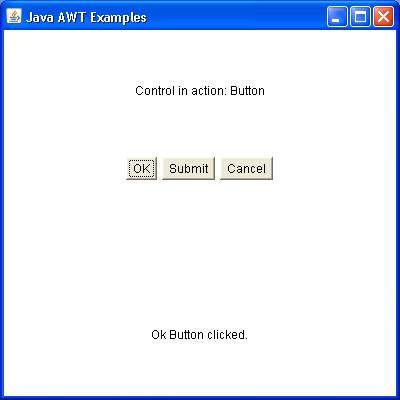
- AWT Tutorial
- AWT - Home
- AWT - Overview
- AWT - Environment
- AWT - Controls
- AWT - Event Handling
- AWT - Event Classes
- AWT - Event Listeners
- AWT - Event Adapters
- AWT - Layouts
- AWT - Containers
- AWT - Menu
- AWT - Graphics
- AWT Useful Resources
- AWT - Quick Guide
- AWT - Useful Resources
- AWT - discussion
AWT Button Class
Introduction
Button is a control component that has a label and generates an event when pressed. When a button is pressed and released, AWT sends an instance of ActionEvent to the button, by calling processEvent on the button. The button's processEvent method receives all events for the button; it passes an action event along by calling its own processActionEvent method. The latter method passes the action event on to any action listeners that have registered an interest in action events generated by this button.
If an application wants to perform some action based on a button being pressed and released, it should implement ActionListener and register the new listener to receive events from this button, by calling the button's addActionListener method. The application can make use of the button's action command as a messaging protocol.
Class declaration
Following is the declaration for java.awt.Button class:
public class Button
extends Component
implements Accessible
Class constructors
| S.N. | Constructor & Description |
|---|---|
| 1 | Button() Constructs a button with an empty string for its label. |
| 2 | Button(String text) Constructs a new button with specified label. |
Class methods
| S.N. | Method & Description |
|---|---|
| 1 | void addActionListener(ActionListener l) Adds the specified action listener to receive action events from this button. |
| 2 | void addNotify() Creates the peer of the button. |
| 3 | AccessibleContext getAccessibleContext() Gets the AccessibleContext associated with this Button. |
| 4 | String getActionCommand() Returns the command name of the action event fired by this button. |
| 5 | ActionListener[] getActionListeners() Returns an array of all the action listeners registered on this button. |
| 6 | String getLabel() Gets the label of this button. |
| 7 | <T extends EventListener> T[] getListeners(Class<T> listenerType) Returns an array of all the objects currently registered as FooListeners upon this Button. |
| 8 | protected String paramString() Returns a string representing the state of this Button. |
| 9 | protected void processActionEvent(ActionEvent e) Processes action events occurring on this button by dispatching them to any registered ActionListener objects. |
| 10 | protected void processEvent(AWTEvent e) Processes events on this button. |
| 11 | void removeActionListener(ActionListener l) Removes the specified action listener so that it no longer receives action events from this button. |
| 12 | void setActionCommand(String command) Sets the command name for the action event fired by this button. |
| 13 | void setLabel(String label) Sets the button's label to be the specified string. |
Methods inherited
This class inherits methods from the following classes:
java.awt.Component
java.lang.Object
Button Example
Create the following java program using any editor of your choice in say D:/ > AWT > com > tutorialspoint > gui >
AwtControlDemo.java
package com.tutorialspoint.gui;
import java.awt.*;
import java.awt.event.*;
public class AwtControlDemo {
private Frame mainFrame;
private Label headerLabel;
private Label statusLabel;
private Panel controlPanel;
public AwtControlDemo(){
prepareGUI();
}
public static void main(String[] args){
AwtControlDemo awtControlDemo = new AwtControlDemo();
awtControlDemo.showButtonDemo();
}
private void prepareGUI(){
mainFrame = new Frame("Java AWT Examples");
mainFrame.setSize(400,400);
mainFrame.setLayout(new GridLayout(3, 1));
mainFrame.addWindowListener(new WindowAdapter() {
public void windowClosing(WindowEvent windowEvent){
System.exit(0);
}
});
headerLabel = new Label();
headerLabel.setAlignment(Label.CENTER);
statusLabel = new Label();
statusLabel.setAlignment(Label.CENTER);
statusLabel.setSize(350,100);
controlPanel = new Panel();
controlPanel.setLayout(new FlowLayout());
mainFrame.add(headerLabel);
mainFrame.add(controlPanel);
mainFrame.add(statusLabel);
mainFrame.setVisible(true);
}
private void showButtonDemo(){
headerLabel.setText("Control in action: Button");
Button okButton = new Button("OK");
Button submitButton = new Button("Submit");
Button cancelButton = new Button("Cancel");
okButton.addActionListener(new ActionListener() {
public void actionPerformed(ActionEvent e) {
statusLabel.setText("Ok Button clicked.");
}
});
submitButton.addActionListener(new ActionListener() {
public void actionPerformed(ActionEvent e) {
statusLabel.setText("Submit Button clicked.");
}
});
cancelButton.addActionListener(new ActionListener() {
public void actionPerformed(ActionEvent e) {
statusLabel.setText("Cancel Button clicked.");
}
});
controlPanel.add(okButton);
controlPanel.add(submitButton);
controlPanel.add(cancelButton);
mainFrame.setVisible(true);
}
}
Compile the program using command prompt. Go to D:/ > AWT and type the following command.
D:\AWT>javac com\tutorialspoint\gui\AwtControlDemo.java
If no error comes that means compilation is successful. Run the program using following command.
D:\AWT>java com.tutorialspoint.gui.AwtControlDemo
Verify the following output
